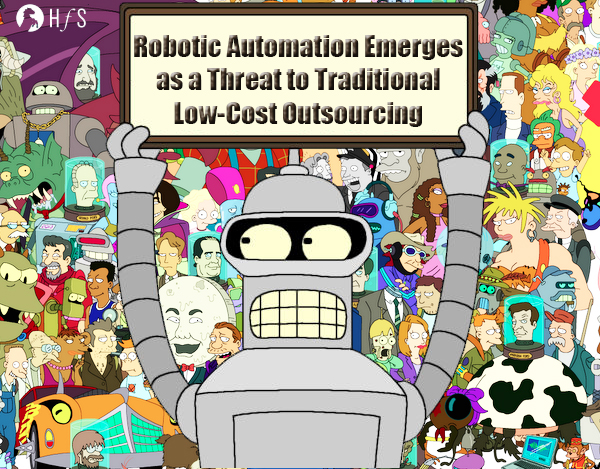Outsourcing has always been about people, process and technology. ?Scratch that. ?It?s about process and technology, with people an optional extra. ?So without any further explanation of this amazing trend where people will no longer be needed, let?s hand you over to our resident expert in robotics (among many other things), Jim Slaby?.

?Listen and understand. Robots are out there. They can?t be bargained with. They can?t be reasoned with. They don?t feel pity, or remorse, or fear. And they absolutely will not stop, ever, until you have knocked another 50% off your outsourced labor costs.? (With apologies to James Cameron.)
Stop me if you?re heard this one before:
?Chief, I need to add ten FTEs to handle the additional order-entry and logistics workload we anticipate once our new product launches in six months.?
?Oy. You know we don?t have the budget for that. What about automating the process??
?IT quoted it at 18 months and $1M to do under their standard SOA and BPM development approach. Even if we had the money, that wouldn?t come close to meeting our launch deadline.?
?So what are our sourcing options??
?We can hire 10 FTEs for $800K in the States, or $300K India.?
?Right, India it is.?
?Actually, I have one other option. We can do it for $120K in Robotistan?
?Robotistan? Where the hell is that??
?It?s right here. I?m going to have my own business process analysts create software robots to do the work. We can get the robots up and running in five months. The robots will do the work for less than half the cost of Indian FTEs. And nobody?s job gets shipped offshore.?
Oh, you hadn?t heard that one? Neither had HfS until recently, when we started researching a UK startup by the name of Blue Prism. It makes a software development toolkit and methodology that lets non-engineers quickly create software robots to automate rules-driven business processes.
Think about this for a moment. If you were a buyer, how fast would you jump at the option to hire FTEs at rates that undercut the Indian body shops by 50% ? without sending jobs offshore? (?Hire? isn?t the right word, of course: it?s ?create?.)? If you were a BPO services provider, how would you like to build a software robot to automate a business process for one client, and then resell copies of that robot to a dozen other clients in the same vertical? If you were an Indian outsourcer, how great would it be to hand off your dullest, most rote outsourcing work to robots so your human workers could take on more engaging tasks, thereby reducing your horrific churn rate ? and by the way, undercutting your competitors on price?
Naturally, there are caveats. Not every business process is going to be well-suited to robotic automation: the more rules-driven it is, the better. Think of any rote, repetitive back-office process that does not require human judgment or much exception handling: swivel-chair data entry into multiple systems, account review and maintenance, creation of online access credentials (user IDs and passwords), general ledger account maintenance.

James R Slaby is HfS Research Director for newfangled things like Robotic Automation (click to download his report)
Furthermore, you?re going to need some buy-in from IT, and they may find the project a little fishy: what are business process analysts doing developing software? You may have to build a modest pilot first to convince them it works, as you?ll need their help with necessities like putting together a virtual machine cluster to run the robots on. (Getting your executives on board should be considerably easier once you show them the eye-popping business case in which not only does nobody?s job get shipped to India, but you may save enough to protect some onshore jobs or reshore some higher-value work.)
There is a learning curve on the environment, typically two to four months to master the tools to model, automate, test and optimize your new robots. But after the initial ramp-up, development time drops dramatically for each new business process, in part because new robots may be able to reuse components created for earlier ones.
Naturally, HfS didn?t take Blue Prism?s word for it: we studied two of its early adopters, a large wireless carrier and a major BPO services provider. Having successfully built very cheap robots to automate a variety of business processes, these people are true believers, avidly looking for new processes to automate. We outline their experiences in the report ?Robotic Automation Emerges as a Threat to Traditional Low-Cost Outsourcing?.
In it, we take a long look at the business cases that led these well-known companies to explore the technology, the obstacles they faced selling it to internal stakeholders, how they identified suitable processes for robots to do, what learning the Blue Prism tools and methodology was like for their business-unit staffers, and how the resulting robots now fit into their existing IT and security infrastructure and governance.
We also make some predictions about how this technology has the potential to dramatically shake up the outsourcing industry, especially those players whose value proposition largely rests on labor arbitrage. The workers of Robotistan have arrived, and they have the potential to thump their human counterparts at their own game. HfS urges BPO buyers, services providers and advisors alike to look at the jaw-dropping economics of robotic automation, and put together a strategy to accommodate and exploit it today.
Click here to download your free copy of??Robotic Automation Emerges as a Threat to Traditional Low-Cost Outsourcing?
Source: http://www.horsesforsources.com/robotistan_011112
air jordan 11 concord unemployment extension the thin man republic wireless space ball drops on namibia matt barkley melanie amaro x factor
No comments:
Post a Comment
Note: Only a member of this blog may post a comment.